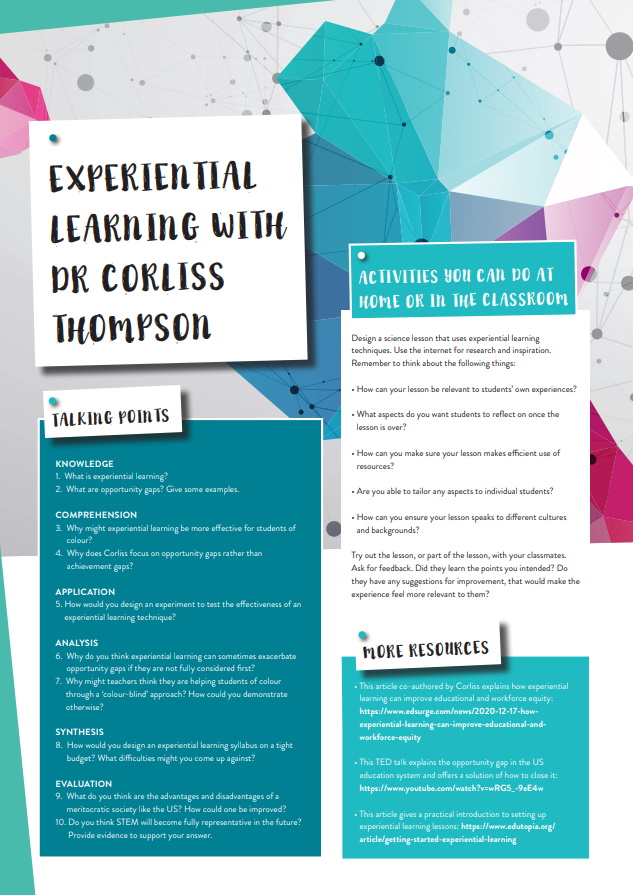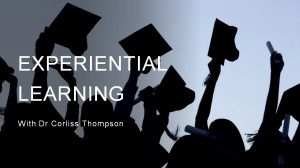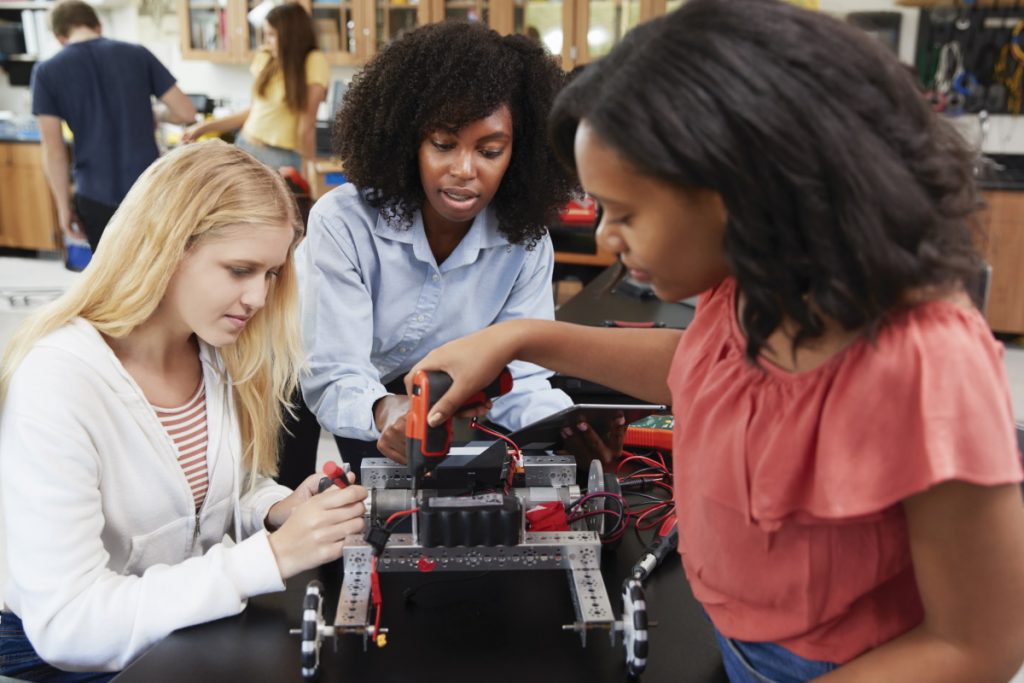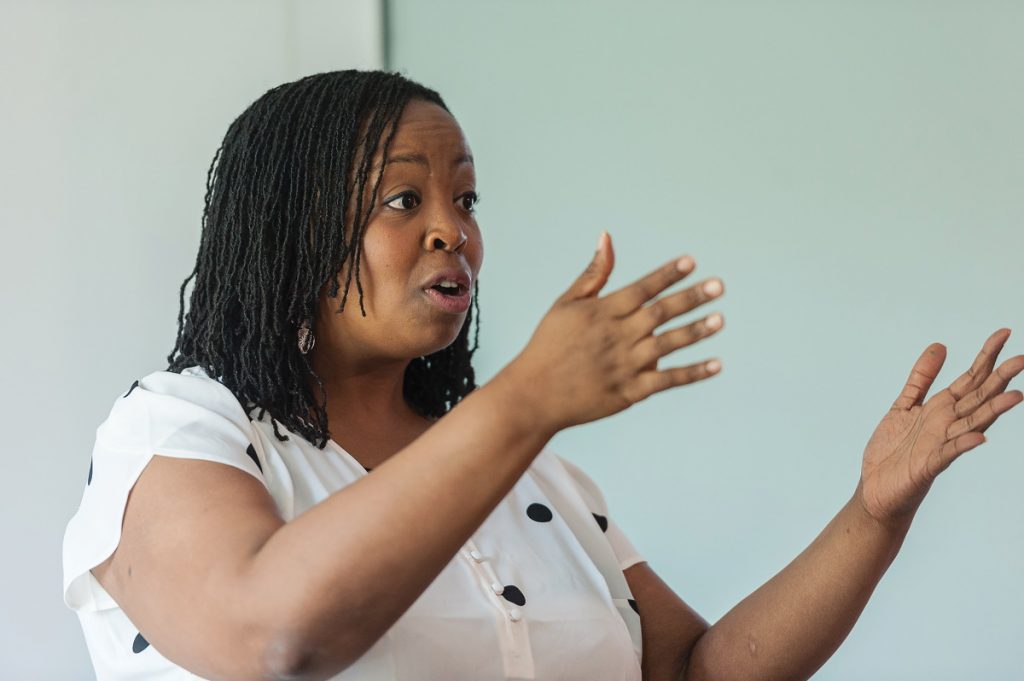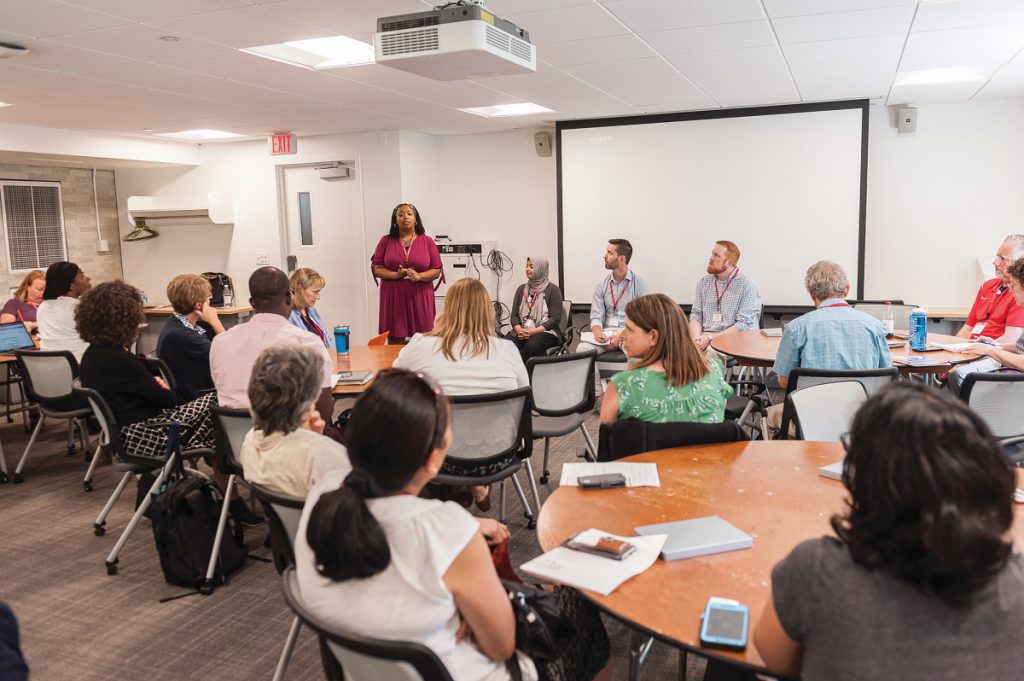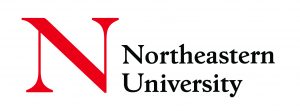What if experiential learning can make STEM more accessible for students of colour?
Students of colour continue to be underrepresented within STEM. Opportunity gaps between different groups of people make it challenging to address this imbalance. Dr Corliss Thompson of Northeastern University is an advocate for experiential learning, which she believes can help combat inequity in STEM recruitment and careers
GLOSSARY
ACHIEVEMENT GAP – when one group of students (e.g. grouped by race) significantly outperforms another
EXPERIENTIAL LEARNING – learning through relevant experience and reflecting on this experience
MERITOCRACY – a society where people gain success through merit
MICROAGGRESSIONS – incidents of indirect, subtle or unintentional discrimination
OPPORTUNITY GAP – the recognition that the circumstances of people’s lives (e.g. race, wealth) can affect their opportunities
QUALITATIVE DATA – comes in the form of words, descriptions, observations and images such as questionnaires or maps
QUANTITATIVE DATA – comes in the form of numbers i.e. the velocity of a river or amount of litter in a particular area
STEREOTYPE THREAT – when people feel themselves at risk of conforming to stereotypes about their social group, leading to feelings such as discomfort or anxiety
STRUCTURAL RACISM – inherent racism within society, such as discrimination (explicit or implicit) within policies, institutions and education systems
We all know that it is easier to learn about a topic when it feels relevant to us. However, people relate to topics differently, depending on a whole range of factors – such as cultural background, parents’ experiences, and expectations for the future. Backed by a growing body of evidence, Dr Corliss Thompson of Northeastern University, USA, believes that this is a key reason why fewer students of colour enter scientific careers. “Studies have shown that there can be disconnections with the curriculum for many students, especially students of colour,” says Corliss. “This is partially due to cultural and linguistic disconnections in the classroom, and also because of the ‘education debt’ that contributes to structural racism around the world.”
This ‘education debt’ Corliss mentions is the fact that students of colour, both historically and in the present, typically have fewer educational resources available to them than their white counterparts, as a result of longstanding social, political and economic patterns that reinforce disadvantage. This is a difficult cycle to escape from – but Corliss believes that experiential learning could be part of the solution, if carried out correctly.
EXPERIENTIAL LEARNING
“Experiential learning is a form of acquiring knowledge and building skills through active engagement in immediate, relevant activities, followed by processing and reflection,” says Corliss. “This then leads to continued learning and reflection into the future.” In other words, lessons are tailored to be relevant to the students they are teaching – they draw on students’ past experiences and interests to introduce them to new ideas and concepts.
Corliss goes on to explain: “Connection to previous experiences and relevance to future experiences is a key part of experiential learning. This technique allows learners to connect their interests and understandings to new ideas and skills in a way that fosters development.” Corliss believes this approach is especially important for teachers and students within under-served communities, given the well-documented link between low economic wealth and fewer educational opportunities.
MAKING IT WORK FOR STUDENTS OF COLOUR
“STEM can be seen as a ‘social identity’, that people can subscribe to or not,” says Corliss. “STEM identity is important for underrepresented minorities, but historically research has pointed out achievement gaps rather than focusing on students’ strengths.” Corliss wants a move away from this negative outlook and instead concentrate on students’ potential, such as by encouraging under-represented students who have shown an interest in STEM to explore it further in relation to their identity and ability.
With this in mind, Corliss’ research focuses on opportunity gaps rather than achievement gaps. One opportunity gap arises from usually well-meaning colour-blind ideologies – when teachers teach all students in the same way, irrespective of racial backgrounds. Although probably done with good intentions, this can put students of colour at a disadvantage, given that standardised lessons are more relevant to the experiences of their white peers – around whom the education system was historically built – than themselves.
There are other common opportunity gaps, too. For one, the US supposedly works on a system of meritocracy – in other words, you get out what you put in. When it comes to education, however, this does not always hold true, because students do not start on a level playing field. If you are disadvantaged from the outset, it can be difficult to catch up. When this is coupled with the effects of structural racism – for example, education institutions may expect students of colour to do less well in exams, so spend less effort preparing them for ambitious careers – it can create a vicious cycle that prevents generations of people from seeking high-skilled careers such as in STEM.
Reference
https://doi.org/10.33424/FUTURUM141
© Northeastern University
ACHIEVEMENT GAP – when one group of students (e.g. grouped by race) significantly outperforms another
EXPERIENTIAL LEARNING – learning through relevant experience and reflecting on this experience
MERITOCRACY – a society where people gain success through merit
MICROAGGRESSIONS – incidents of indirect, subtle or unintentional discrimination
OPPORTUNITY GAP – the recognition that the circumstances of people’s lives (e.g. race, wealth) can affect their opportunities
QUALITATIVE DATA – comes in the form of words, descriptions, observations and images such as questionnaires or maps
QUANTITATIVE DATA – comes in the form of numbers i.e. the velocity of a river or amount of litter in a particular area
STEREOTYPE THREAT – when people feel themselves at risk of conforming to stereotypes about their social group, leading to feelings such as discomfort or anxiety
STRUCTURAL RACISM – inherent racism within society, such as discrimination (explicit or implicit) within policies, institutions and education systems
We all know that it is easier to learn about a topic when it feels relevant to us. However, people relate to topics differently, depending on a whole range of factors – such as cultural background, parents’ experiences, and expectations for the future. Backed by a growing body of evidence, Dr Corliss Thompson of Northeastern University, USA, believes that this is a key reason why fewer students of colour enter scientific careers. “Studies have shown that there can be disconnections with the curriculum for many students, especially students of colour,” says Corliss. “This is partially due to cultural and linguistic disconnections in the classroom, and also because of the ‘education debt’ that contributes to structural racism around the world.”
This ‘education debt’ Corliss mentions is the fact that students of colour, both historically and in the present, typically have fewer educational resources available to them than their white counterparts, as a result of longstanding social, political and economic patterns that reinforce disadvantage. This is a difficult cycle to escape from – but Corliss believes that experiential learning could be part of the solution, if carried out correctly.
EXPERIENTIAL LEARNING
“Experiential learning is a form of acquiring knowledge and building skills through active engagement in immediate, relevant activities, followed by processing and reflection,” says Corliss. “This then leads to continued learning and reflection into the future.” In other words, lessons are tailored to be relevant to the students they are teaching – they draw on students’ past experiences and interests to introduce them to new ideas and concepts.
Corliss goes on to explain: “Connection to previous experiences and relevance to future experiences is a key part of experiential learning. This technique allows learners to connect their interests and understandings to new ideas and skills in a way that fosters development.” Corliss believes this approach is especially important for teachers and students within under-served communities, given the well-documented link between low economic wealth and fewer educational opportunities.
MAKING IT WORK FOR STUDENTS OF COLOUR
“STEM can be seen as a ‘social identity’, that people can subscribe to or not,” says Corliss. “STEM identity is important for underrepresented minorities, but historically research has pointed out achievement gaps rather than focusing on students’ strengths.” Corliss wants a move away from this negative outlook and instead concentrate on students’ potential, such as by encouraging under-represented students who have shown an interest in STEM to explore it further in relation to their identity and ability.
With this in mind, Corliss’ research focuses on opportunity gaps rather than achievement gaps. One opportunity gap arises from usually well-meaning colour-blind ideologies – when teachers teach all students in the same way, irrespective of racial backgrounds. Although probably done with good intentions, this can put students of colour at a disadvantage, given that standardised lessons are more relevant to the experiences of their white peers – around whom the education system was historically built – than themselves.
There are other common opportunity gaps, too. For one, the US supposedly works on a system of meritocracy – in other words, you get out what you put in. When it comes to education, however, this does not always hold true, because students do not start on a level playing field. If you are disadvantaged from the outset, it can be difficult to catch up. When this is coupled with the effects of structural racism – for example, education institutions may expect students of colour to do less well in exams, so spend less effort preparing them for ambitious careers – it can create a vicious cycle that prevents generations of people from seeking high-skilled careers such as in STEM.
LESSONS FOR RESEARCHERS AND TEACHERS
So far, Corliss’ research has focused on qualitative data, with quantitative data soon to come. Nevertheless, her team has already uncovered some key insights. “We know that it is not just hands-on activities that contribute to experiential learning,” says Corliss. “Our study also assessed relationships, the physical environment, and the surrounding culture.” For instance, one type of experiential learning they measured was students experiencing what it is like to be physically present in an engineering firm, building relationships with the engineers and learning the culture of the firm and wider engineering community.
One of the researchers’ principal findings is that a lack of resources can limit opportunities for experiential learning. For instance, industry partnerships, coordination between scientists and teachers, or training teachers in experiential learning all take time and money to set up. “Districts with fewer resources may be at a disadvantage when it comes to providing experiential learning opportunities for students,” says Corliss.
“It becomes more difficult to give students the opportunities to think, solve problems, and gain insight into the relationships and cultures found within STEM professions.” Corliss’ team also found that experiential learning can even have the potential to perpetuate opportunity gaps in certain scenarios. This shows that while experiential learning can be useful, it needs to recognise and address opportunity gaps as a first step. For instance, it can be difficult for teachers to provide a culturally relevant learning experience to students from another culture, if they themselves have little experience or knowledge of what is relevant to those students’ lives. Corliss believes that recognising that structural inequity exists around race is key to making sure that experiential learning is as effective as possible.
 DR CORLISS THOMPSON
DR CORLISS THOMPSON
Associate Teaching Professor
Graduate School of Education
Northeastern University, USA
FIELD OF RESEARCH: STEM Education
RESEARCH PROJECT: Investigating the role of experiential learning in encouraging students of colour to follow careers in STEM.
FUNDERS: National Science Foundation
 DR CORLISS THOMPSON
DR CORLISS THOMPSON
Associate Teaching Professor
Graduate School of Education
Northeastern University, USA
FIELD OF RESEARCH: STEM Education
RESEARCH PROJECT: Investigating the role of experiential learning in encouraging students of colour to follow careers in STEM.
FUNDERS: National Science Foundation
ABOUT STEM CAREERS
Corliss gives her thoughts on why STEM careers should be encouraged for people from all backgrounds.
WHAT IS A STEM MINDSET?
A STEM mindset is a way of thinking characterised by critical thinking skills, growth-orientated mentality, and a willingness to use STEM ideas and skills to address everyday challenges.
WHY ARE STEM CAREERS IMPORTANT?
The United States, along with many other nations, is dependent on a thriving STEM workforce to maintain the health and well-being of its citizens, as well as creating advancements that improve people’s lives. The number of STEM-related jobs available is increasing, at a faster rate than the number of students making STEM-related education choices – particularly in areas such as computer science, which are growing the fastest.
WHY ARE PEOPLE OF SOME BACKGROUNDS UNDERREPRESENTED IN STEM?
There is a shortage of STEM-prepared students in general, but especially for females and some students of colour. There are many suggested reasons why there are fewer women choosing STEM careers, including a shortage of female role models, gender stereotyping, lack of family support and less flexible work environments. When it comes to minorities, factors such as a perceived uninteresting curriculum, microaggressions and stereotype threat are put forward as likely reasons for under-representation, though the exact relationships are not yet fully clear.
HOW HAS EDUCATION CHANGED RECENTLY IN THE US?
US high schools have shifted towards standardised testing and away from comprehension and application of concepts. Due to the pressure to perform well on these tests, teachers are often under the misguided impression that direct instruction is the best way to prepare students. However, a large body of evidence suggests that traditional classroom settings disengage students and do not promote the skills needed for modern STEM jobs and civic life. The National Research Council found that effective STEM instruction involves students’ interests, backgrounds and previous knowledge.
WHAT HELPS PEOPLE CHOOSE STEM CAREERS?
Giving students the support and structures they need throughout their educational career is key. Early exposure to practical, real-life STEM examples, collaborations with local higher education STEM departments, mentorship, and informal STEM learning environments such as camps and afterschool programmes can all broaden students’ experience of STEM. Outside of the classroom, hands-on STEM activities such as internships and research opportunities can help cement students’ interests in STEM careers.
STEM ORGANISATIONS TO LOOK OUT FOR
• The National Action Council for Minorities in Engineering (NACME) provides scholarships and career advice to support Black/African American, Native/American Indian, and Latinx/Hispanic American young women and men taking on STEM careers: https://www.nacme.org/about-us
• In the UK, STEM Learning is an organisation committed to furthering STEM education, through training teachers, bringing STEM role models into schools and providing long-term support for schools: https://www.stem.org.uk
• Collegexpress has a list of STEM Scholarship Opportunities for Minority Students: https://www.collegexpress.com/articles-and-advice/financial-aid/blog/stem-scholarship-opportunities-minority-students/
• This webpage provides a list of diversity initiatives in STEM fields in the US: https://libguides.mssm.edu/diversity/orgs
• Black British Professionals in STEM (BBSTEM) campaigns for balance and representation of Black individuals in STEM and runs the Bridge Mentoring Scheme: https://bbstem.co.uk
DIVERSITY IN STEM: SOME STATISTICS FROM THE US
• Between 1990 and 2018, STEM employment grew by 79% in the US. Computer jobs increased by 338% in the same period.
• Blacks make up 11% of the US workforce overall but represent 9% of STEM workers, while Hispanics comprise 16% of the US workforce but only 7% of all STEM workers. Representation has improved since 1990 but is not there yet.
• Women comprise 47% of all employed adults, but only make up 14% of engineers, 25% of computer workers, and 39% of physical scientists. Representation is roughly proportionate for the life sciences and maths, and women are over-represented (75%) in healthcare careers.
• STEM workers earn more on average than non-STEM workers of a similar education level. https://www.pewresearch.org/social-trends/2018/01/09/diversity-in-the-stem-workforce-varies-widely-across-jobs/
MEET CORLISS
WHAT DID YOU WANT TO BE WHEN YOU WERE YOUNGER?
As a young child, I wanted to be a meteorologist. I was fascinated by weather and the outdoors, and enjoyed seeing the local meteorologists on TV. I was interested in how they could talk about complex ideas in a way that was useful to people’s everyday lives.
DID YOU EXPERIENCE ANY OPPORTUNITY GAPS GROWING UP?
I was raised in a middle-class, suburban household in a predominantly white area, which influenced my personal cultural norms. My parents did make an effort to teach us Black history and gave us opportunities to engage with other African Americans. They also bought us Black dolls, and our house was full of Black art and photography.
HOW DO YOU APPROACH CHALLENGES, BOTH PERSONAL AND PROFESSIONAL?
The ability to learn is a gift. We can each learn what we need to address our challenges, and learning comes in many different shapes and formats. I constantly learn through reading, non-fiction audiobooks and podcasts that development, business and leadership. We also need the help of others to further our learning. I often only realise the limitations of my knowledge on a topic when I talk to others about it, and this is an opportunity in itself. Once all this learning has been taken on board, we need a way to process it. I find that journaling or any kind of writing helps me find clarity, along with simply sitting quietly or letting my mind wander while I walk in nature.
DO YOU SEE YOURSELF AS A SUCCESS STORY?
I do, though I don’t consider my experience as a unique success. My successes have been built on the shoulders of people in my life who were successes in their own right. My family has a history of further education, even when the institutions were very much dominated by white students. I was therefore expected to go to college and pursue a career, and my family have helped me out financially and emotionally at many different times. On the other hand, even though I haven’t frequently experienced overt discrimination, I have experienced structural racism. I have had to find ways of dealing with these challenges to find success.
WHO INSPIRES YOU?
I am inspired by the leaders who make a difference in the world, while also looking after their families, health and well-being. Some of the leaders I count are within my own family. Others I have worked with directly, and others I am inspired by from a distance.
TOP TIP FOR YOUNG PEOPLE OF COLOUR
We all come from different backgrounds and people need different sorts of help to learn – especially social and emotional learning, which is how we become a well-rounded person. Do what is needed to take care of your well-being and ask for help when needed.
TOP TIP FOR TEACHERS
Teachers have a critical role in supporting the learning and well-being of people. To ensure they can do this effectively, selfcare must come first.
Write it in the comments box below and Corliss will get back to you. (Remember, researchers are very busy people, so you may have to wait a few days.)


